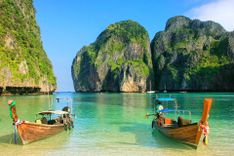Boat tours and snorkelling on Ko Tao
Round-island boat tours are available at Mae Hat or through your bungalow, with stops for snorkelling and swimming; these take in snorkelling in the Japanese Gardens off Ko Nang Yuan, but you’ll have to pay the B100 entrance fee if you set foot on the island to climb up to the viewpoint. Some dive companies will take along snorkellers, usually on their afternoon trips, when they visit the shallower sites.
Eco Tao
With so many divers and other visitors coming to this tiny island, the pressures on the environment, both above and below the waterline, are immense. To minimize your impact, look out for the work of a community group, Save Koh Tao, which has been formed among concerned locals and resident Westerners, with a sub-group devoted to marine conservation. Activities include a turtle-release programme, erosion control, a campaign for septic tanks to stop waste water being run straight into the sea, coral nurseries and more than half a dozen artificial reefs around Ko Tao, which allow divers to practise their skills without damaging coral. Their monthly land and underwater clean-ups are given a big splash once a year, during the two-day Underwater Festival in March, which involves mass beach-cleaning, fundraising, live bands and turtle releasing. Look out also for Sabai Jai, a free quarterly eco-travel magazine produced by the owner of Yakuzen Japanese Bath Village.
Much of what visitors can do to help is common sense: avoiding littering, recycling where possible and turning down plastic bags when you’re shopping. The island suffers from a scarcity of water, with occasional droughts during the hot season after a poor rainy season, so conserve water whenever possible. In the sea, the main rule is not to touch the coral, which may mean avoiding snorkelling when the water is low from April to September – if in doubt, ask locally for advice, be careful and go out at high tide. Don’t take away dead shells, and don’t buy coral or shell jewellery. If you’re feeling really keen, check whether your bungalow resort has a septic tank. And some dive schools have a Save Koh Tao donation box.
Diving off Ko Tao
Some of the best dive sites in Thailand are found off Ko Tao, which is blessed with outstandingly clear (visibility up to 35m), safe and relatively deep water close in to shore. On top of that, there’s a kaleidoscopic array of coral species and other marine life, and you may be lucky enough to encounter whale sharks, barracudas, leatherback turtles and pilot whales. Diving is possible at any time of year, with sheltered sites on one or other side of the island in any season – the changeover from southwest to northeast monsoon in November is the worst time, while visibility is best from April to July, in September (usually best of all) and October. Ko Tao supports several evacuation centres, clinics that specialize in diving medicine, while the nearest recompression chamber is on Ko Samui, ninety minutes away by speedboat.
Main dive sites
Ko Nang Yuan
Surrounded by a variety of sites, with assorted hard and soft corals and an abundance of fish: the Nang Yuan Pinnacle, a granite pinnacle with boulder swim-throughs, morays and reef sharks; Green Rock, a maze of boulder swim-throughs, caves and canyons, featuring stingrays and occasional reef sharks; Twins, two rock formations covered in corals and sponges, with a colourful coral garden as a backdrop; and the Japanese Gardens, on the east side of the sand causeway, which get their name from the hundreds of hard and soft coral formations here and are good for beginners and popular among snorkellers.
White Rock
(Hin Khao) Between Hat Sai Ree and Ko Nang Yuan, where sarcophyton leather coral turns the granite boulders white when seen from the surface; also wire, antipatharian and colourful soft corals, and gorgonian sea fans. Plenty of fish, including titan triggerfish, butterfly fish, angelfish, clown fish and morays.
Shark Island
Large granite boulders with acropora, wire and bushy antipatharian corals, sea whips, gorgonian sea fans and barrel sponges. Reef fish include angelfish, triggerfish and barracuda; there’s a resident turtle, and leopard and reef sharks may be found as well as occasional whale sharks.
Hinwong Pinnacle
At Ao Hinwong; generally for experienced divers, often with strong currents. Similar scenery to White Rock, over a larger area, with beautiful soft coral at 30m depth. A wide range of fish, including blue-spotted fantail stingrays, sweetlips pufferfish and boxfish, as well as hawksbill turtles.
Chumphon
or Northwest Pinnacle A granite pinnacle for experienced divers, starting 14m underwater and dropping off to over 36m, its top covered in anemones; surrounded by several smaller formations and offering the possibility of exceptional visibility. Barrel sponges, tree and antipatharian corals at deeper levels; a wide variety of fish, in large numbers, attract local fishermen; barracudas, batfish, whale sharks (seasonal) and huge groupers.
Southwest Pinnacle
One of the top sites in terms of visibility, scenery and marine life for experienced divers. A huge pyramid-like pinnacle rising to 6m below the surface, its upper part covered in anemones, with smaller pinnacles around; at lower levels, granite boulders, barrel sponges, sea whips, bushy antipatharian and tree corals. Big groupers, snappers and barracudas; occasionally, large rays, leopard and sand sharks, swordfish, finback whales and whale sharks.
Sail Rock
(Hin Bai) Midway between Ko Tao and Ko Pha Ngan, emerging from the sand at a depth of 40m and rising 15m above the sea’s surface. Visibility of up to 30m, and an amazing 10m underwater chimney (vertical swim-through). Antipatharian corals, both bushes and whips, and carpets of anemones. Large groupers, snappers and fusiliers, blue-ringed angelfish, batfish, kingfish, juvenile clown sweetlips and barracuda; a possible spot for sighting whale sharks and mantas.
Thinking of travelling to Thailand? Start planning by learning about how to get there.





